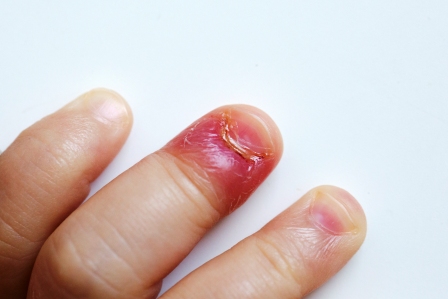Paronychia: Ayurvedic treatment and Home remedies

Article by Prof. MS Krishnamurthy MD(Ayu), PhD.
Paronychia is the infectious condition of the hand or foot where the nail and skin meet at the side or the base of a finger or toenail. The infection can start suddenly or gradually. The incidence is common among the people who are engaged in household works.
Table of Contents
Causative factors
Common causative factors for Paronychia:
Improper trimming of the cuticles or nail bed or edges
Contact of chemicals
Repeated exposure to cold/ aqueous matters
Injury to the nail beds or folds of the nail and finger
Nail biting
Finger sucking etc
Classification
Classification of Paronychia:
According to its onset it is classified into two kinds as below-
Acute paronychia-which is caused suddenly due to the infections of the folds of tissue surrounding the nail of a finger. The infection usually starts at the side of the nail, with local redness, swelling, and pain. Direct or indirect trauma is the common cause behind such kind of acute manifestations.
Washing of the utensils, cloth wash, minor injury from a thorn, nail biting, biting, finger sucking, ingrown nail or improper manicure procedures etc are the factors causing such kind of diseased conditions.
Chronic paronychia is the infection of the folds of tissue surrounding the nail of a finger or a toe lasting for more than six weeks. The incident is common among the people whose hands or feet are subject to moist local environments repeatedly. Washer men (Dhobis), hospital workers, cleaners and house maids are the common sufferers of this kind of problems.
Aggressive trimming the cuticles, or frequent contact with chemicals is the another strong causative factors for this kind of problems.
Ayurvedic correlation
Paronychia-as per Ayurveda system of Medicine:
Ayurveda refers Paronychia as Kunakha. The work Kunakha is derived by Ku (meaning-bad) and Nakha refers Nail.
So it is a bad nail condition caused due to unhygienic condition of the individual. Even though specific causative factors have been not referred, all factors referred in the above contexts can be considered as the true factors for the manifestation of Kunakha (Paronychia) as all are in supportive of unhygienic conditions.
Further, ‘unhygienic’ relates to the infections of the nail bed and hence paronychia is manifested.
So Acharyas of Ayurveda considered it as a Pitta dominant Tridoshaja condition.
Line of treatment
Line of treatment of Kunakha(Paronychia):
The causative factor should be checked immediately. Further,the measures are adopted to pacify vata and Pitta dosha. Shothahara(anti inflammatory), Pittahara (non septic) and Shoolahara(anti inflammatory) medicaments are recommended.
Ayurvedic formulations
Formulations of choice in Kunakha(paronychia):
For external application-
Jatyadi taila
Panchaguna taila
Ropana taila
Gandhakadya malahara
Jasadamrita malahara
Marma gulika etc
Internal medication-
Gandhaka rasayana
Triphala guggulu
Arogyavardhini
Bilvadi gulika
Nimbadi guggulu
Amritadi guggulu
Kaishora guggulu etc
Yoga mentioned in Sahasra yoga
1. Kulana Khattinu Kulambu
Home remedies
Home remedies for Paronychia (Kunakha):
In acute conditions of Paronychia, a cotton cloth is soaked in warm water mixed with turmeric powder and that cloth is tied around the nail bed.3-4 times if it is carried considerable benefit is observed.
Beaten rice (Poha in Hindi) powder is mixed with a pinch of pepper and turmeric powder. This is spread around the nail bed and wrapped with a cloth for a day. This reduces the swelling and pain in paronychia.
Last drop
Ayurveda denotes each and every ill health condition which may be minor or major. It has explained relative treatment measures with appropriate doshic concepts and line of treatments.
The clever physician is free enough to make the decision while selecting formulation for such a cure. Great idea and general knowledge will do wonder in treating the diseases which may be minor or major disorder depending upon the time of manifestation and stage of the illness.







3 comments
Dr.J.S.Makkar
Thank you prof. Dr. M.S.krishnamurthy & Dr. Hebbar
For explaining topics and Upgrading concepts in modern way, Keep it UP????.
And one thing
Once i had tried Nalparmadi kera thailam over this condition and it works, whats your views?
With regards
Dr. J. S. Makkar
Deep ayu clinic,(punjab)
Dr J V Hebbar MD(Ayu)Author
apply Mahatikta lepam – 2 times a day. After 30 minutes, she can wash off with hot water, or it can be left on the place, without washing
MM ShivsppSh
putting a lemon with hole on finger you get relief within a day